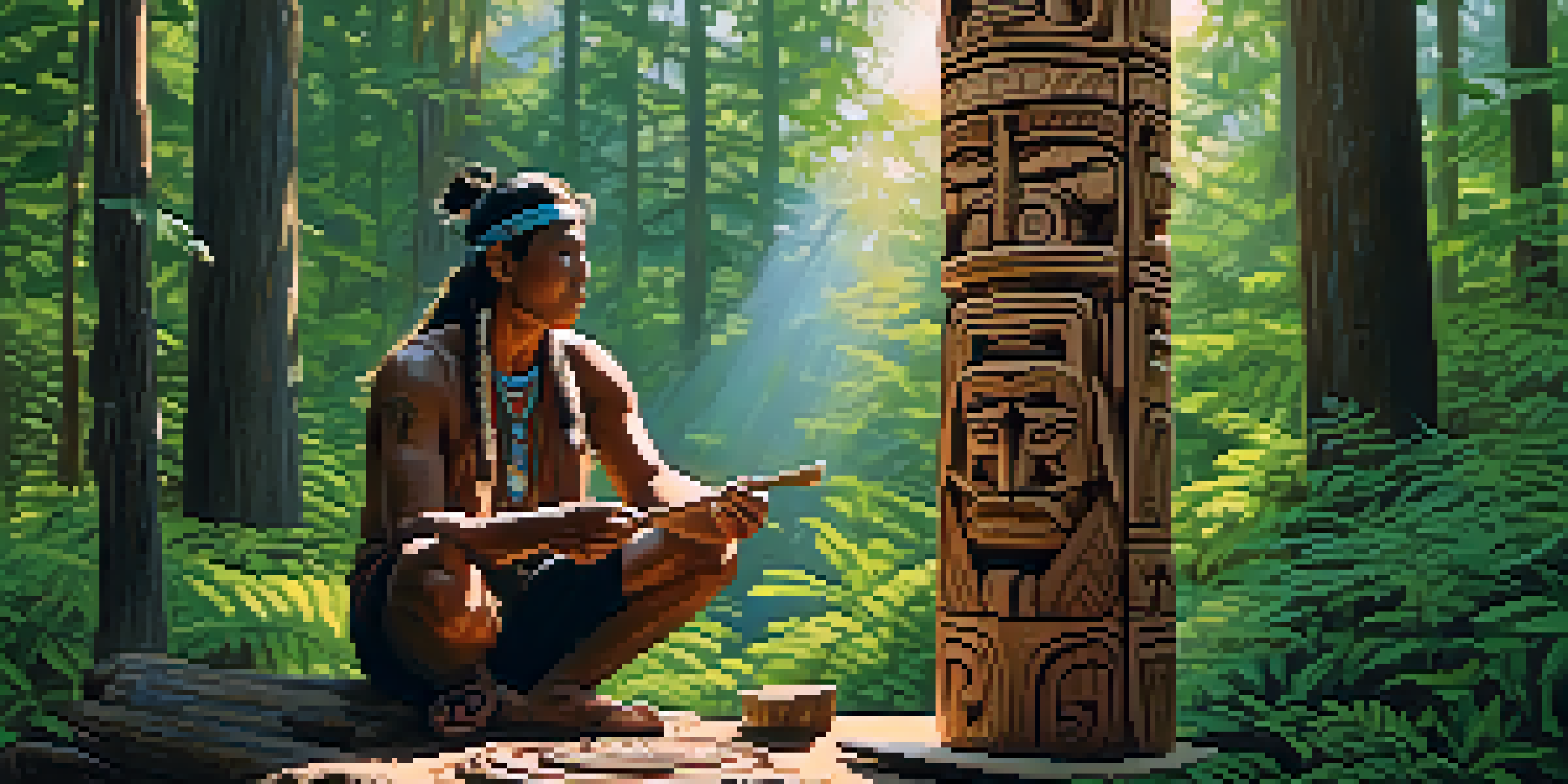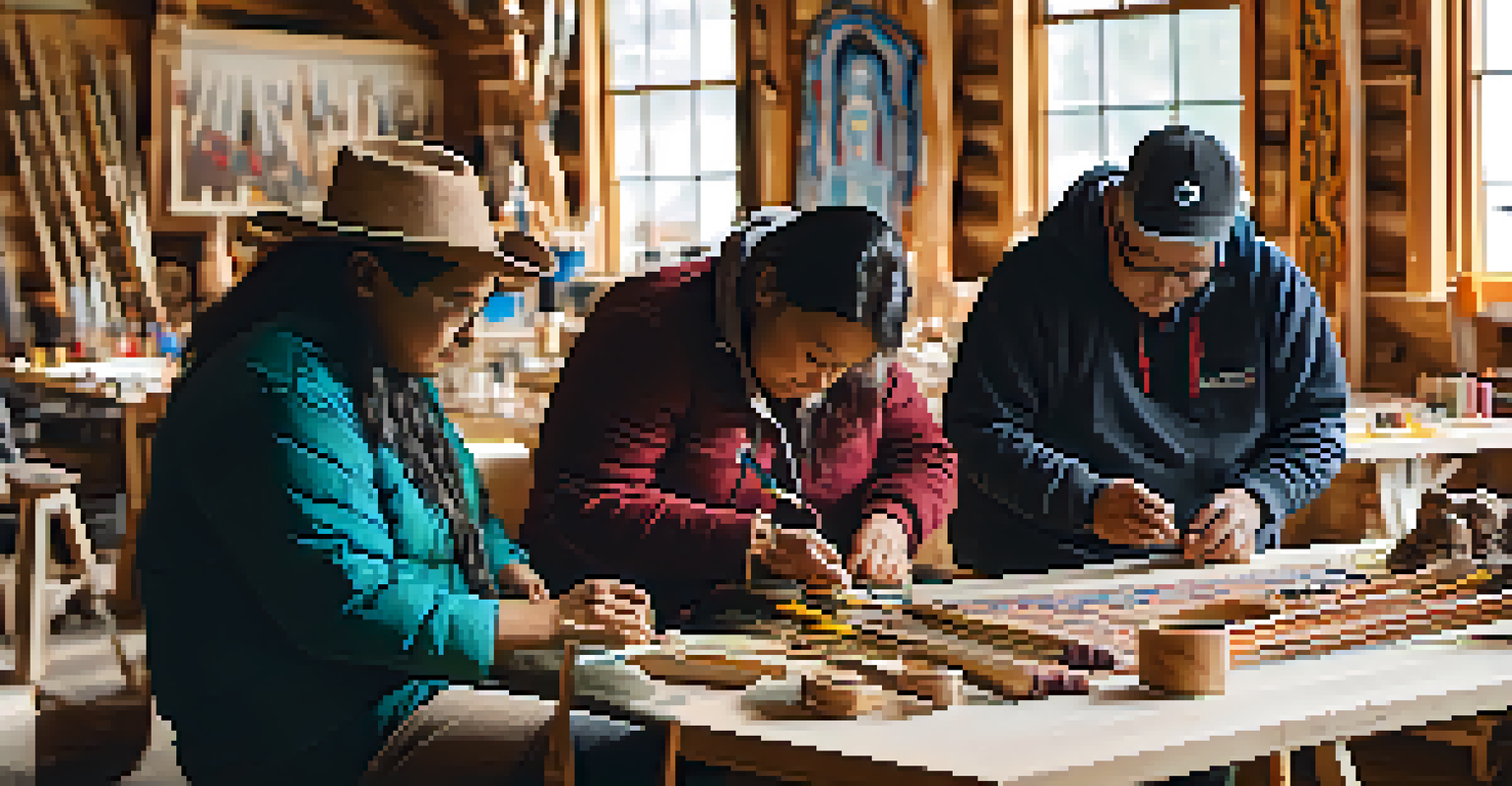The Impact of Colonization on Indigenous Carving Practices

Understanding Indigenous Carving Before Colonization
Indigenous carving practices have deep roots in cultural traditions, often serving as a means of storytelling and preserving history. These carvings, made from wood, stone, and bone, were not just artistic expressions but also played significant roles in rituals and community identity. Each piece told a story, conveying spiritual beliefs and ancestral connections, which were vital for passing down knowledge through generations.
Art is a reflection of the culture from which it comes. To suppress that art is to suppress the culture itself.
Before colonization, these practices were celebrated and respected within Indigenous communities. Carving was a communal activity, often involving collaboration among family members and clans. This collective approach fostered a rich environment where skills were honed, and cultural significance was deeply understood.
The intricate designs and techniques varied widely among different Indigenous groups, showcasing a diverse range of styles and meanings. From totem poles in the Pacific Northwest to intricate masks in the Amazon, each carving was a reflection of the natural world and the community's relationship with it.
The Arrival of Colonizers and Initial Impacts on Art
With the arrival of European colonizers, Indigenous cultures faced significant upheaval, leading to immediate impacts on their carving practices. Colonizers often viewed these artistic expressions as primitive or inferior, dismissing the cultural value embedded in the craftsmanship. This perception led to a decline in the appreciation and support for traditional carving methods.

Moreover, the introduction of new materials and tools by colonizers altered the landscape of Indigenous carving. While some embraced these changes, incorporating metal tools and foreign materials, others felt that this shift diluted their cultural integrity and authenticity. This tension between adaptation and preservation created a complex dynamic within Indigenous communities.
Impact of Colonization on Carving
Colonization led to the suppression of Indigenous carving practices, altering traditional methods and diminishing cultural significance.
The demand for carvings from colonizers often resulted in the commodification of these art forms. Many Indigenous artisans found themselves creating pieces tailored to European tastes rather than their own cultural narratives, which led to a disconnection from their traditional practices.
Cultural Suppression and Loss of Traditional Knowledge
Colonization not only affected the art itself but also aimed to suppress the cultures that birthed these practices. Missionaries and colonial authorities often discouraged Indigenous peoples from practicing their traditions, viewing them as obstacles to civilization. This suppression led to a significant loss of traditional knowledge, including carving techniques passed down through generations.
The past is not dead; it is living in us, and will be alive in the future we are creating.
As cultural practices were marginalized, the younger generations became increasingly disconnected from their heritage. The lack of mentorship and guidance in traditional carving methods threatened the very survival of these art forms. Many skills and stories were lost, as artisans struggled to navigate a world that devalued their cultural identity.
Despite these challenges, some communities worked tirelessly to preserve their carving knowledge. Elders and artists began to document their techniques and stories, hoping to rekindle interest and appreciation for traditional practices in a changing world.
Resilience and Revival of Indigenous Carving Practices
In recent years, there has been a resurgence of interest in Indigenous carving practices, as many communities seek to reclaim their cultural identities. Artists are blending traditional techniques with contemporary themes, creating pieces that resonate with both Indigenous and global audiences. This revival not only honors the past but also reflects the current realities and aspirations of Indigenous peoples.
Workshops and educational programs have emerged, aiming to pass down traditional skills to younger generations. These initiatives encourage community participation and foster a sense of pride in Indigenous heritage, ensuring that carving practices do not fade into obscurity. As a result, a new generation of craftsmen and craftswomen is emerging, eager to share their stories through art.
Revival of Indigenous Art Practices
Recent years have seen a resurgence in Indigenous carving, with artists blending traditional techniques and contemporary themes to reclaim cultural identity.
This revival is also being supported by a growing market for Indigenous art, where collectors and enthusiasts are increasingly recognizing the cultural significance of these pieces. This not only provides economic opportunities for artists but also helps to elevate the status of Indigenous carving in the art world.
The Role of Museums and Cultural Institutions
Museums and cultural institutions play a pivotal role in the preservation and promotion of Indigenous carving practices. By showcasing traditional and contemporary works, these institutions help raise awareness about the cultural significance of Indigenous art. They provide spaces for dialogue, education, and collaboration between Indigenous artists and the broader public.
Many museums have also partnered with Indigenous communities to ensure that their narratives are accurately represented. This collaboration helps to create exhibits that honor the rich history and ongoing evolution of carving practices, rather than presenting them as relics of the past. By amplifying Indigenous voices, museums can contribute to a more nuanced understanding of these art forms.
Additionally, educational programs offered by these institutions can help foster appreciation and respect for Indigenous carving. Workshops, lectures, and demonstrations allow visitors to engage with the art form in meaningful ways, bridging the gap between cultures and encouraging deeper connections.
Contemporary Challenges Faced by Indigenous Carvers
Despite the revival of Indigenous carving practices, contemporary artists still face numerous challenges. Issues such as funding, access to materials, and the impact of globalization can hinder their ability to create and promote their work. Moreover, the appropriation of Indigenous art by outside artists can undermine the authenticity and cultural significance of these practices.
Navigating the delicate balance between tradition and modernity is another challenge for many Indigenous carvers. While some embrace innovation, others feel pressure to adhere strictly to traditional methods, fearing that deviation may lead to cultural dilution. This internal struggle can create tension within communities as artists seek to define their identities in a rapidly changing world.
Role of Institutions in Preservation
Museums and cultural institutions play a crucial role in preserving Indigenous carving practices by accurately representing their narratives and fostering community engagement.
Furthermore, the ongoing effects of colonization continue to impact Indigenous communities, leading to social, economic, and political challenges that can distract from artistic pursuits. Many carvers find themselves advocating for their rights and cultural recognition, often prioritizing these issues over their artistic endeavors.
Looking Forward: The Future of Indigenous Carving
The future of Indigenous carving practices lies in the hands of the communities that nurture them. As more Indigenous artists emerge, there is an opportunity to redefine what carving means in the context of contemporary society. By blending traditional techniques with modern themes, these artists can create works that resonate with diverse audiences while honoring their heritage.
Additionally, fostering collaborations between Indigenous and non-Indigenous artists can lead to innovative projects that celebrate cultural exchange and understanding. These partnerships can help break down barriers and promote mutual respect, allowing for a richer dialogue about art and identity.

Ultimately, the survival of Indigenous carving practices is about more than just art; it’s about cultural resilience and the ongoing journey of reclaiming identity. As communities continue to revitalize their traditions and share their stories, Indigenous carving will undoubtedly evolve, reflecting both the past and the vibrant future of Indigenous peoples.